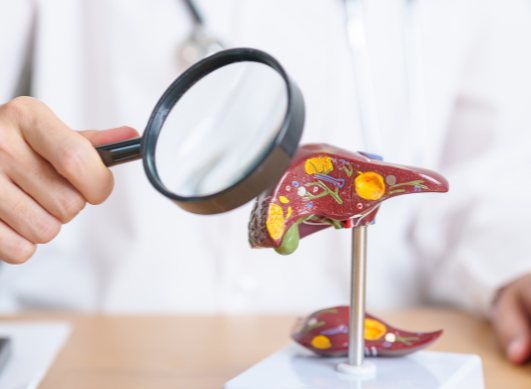NASH diagnosis: Carenity members tell their story
Published 10 Mar 2020 • Updated 13 Mar 2020 • By Josephine O'Brien
Our members affected by non-alcoholic fatty liver disease (NAFLD) and non-alcoholic steatohepatitis (NASH) have graciously told us about the journey with their diagnosis! Symptoms, emotions, tests and examinations, medical care, treatments... read their story about their diagnosis.
Survey conducted by Carenity with 124 patients living in the UK, France, Germany, Spain and Italy.


On average, patients waited more than 5 years to be diagnosed and consulted 3 doctors before reaching their diagnosis.
Carenity members living with NAFLD spent on average over five years to get a diagnosis! The most common symptoms that alerted them to a problem were fatigue and abdominal pain.
Fatigue | Abdominal pain | Vomiting | Bloating | Pain below ribs | Nausea| Heartburn | Back pain | Abnormal bloodwork | Elevated liver enzymes | Weight gain
Before diagnosis: the impact of NAFLD
We asked our members about the impacts the symptoms caused by NAFDL had on their daily life before reaching a diagnosis, and this is what they had to say:
 Chronic fatigue- 73%
Chronic fatigue- 73%
 Leisure and physical activity - 45%
Leisure and physical activity - 45%
 Family life - 40%
Family life - 40%
 Love life - 36%
Love life - 36%
 Social life - 35%
Social life - 35%
 Professional life - 32%
Professional life - 32%
 Chronic pain - 32%
Chronic pain - 32%
The majority of respondents reported that chronic fatigue had the greatest impact on their daily life before the diagnosis. Fortunately, 39% of respondents reported that only one part of their daily life was impacted by the symptoms prior to reaching a diagnosis. Members in general felt that the symptoms impacted their social or professional life the least.
Before being diagnosed, only 36% of patients researched their symptoms online in an attempt to find out what was wrong with them. A majority of those individuals reported they did their research by typing their symptoms into Google and going from there.
The majority of respondents decided not to try any alternative therapies for their NAFLD such as homeopathy, with only 16% responding that they did. Those who did try alternative therapies reported use of milk thistle, acupuncture, arnica, dandelion, cupping therapy, Omega 3 and essential oils.
Being diagnosed with NAFLD: what they had to say
For many diseases, the road to diagnosis is peppered with a misdiagnosis/misdiagnoses. However, with NAFLD, only 19% of patients had a misdiagnosis before discovering they had it. The following were the most common misdiagnoses:
Chronic fatigue syndrome | Gallstones | Hepatitis A | Type 2 diabetes | Fibromyalgia | Mental illness
Although only 19% of members reported a misdiagnosis, the misdiagnosis did result in causing considerable stress.
"I was ill for many years with low platelet count, chronic fatigue, very high pulse rate, but kept being told there was nothing wrong with me. I thought I was going mad."
"My misdiagnosis lasted years and affected my life on a daily basis."
"My GP was on holiday when my results came back, so another GP phoned me at work declaring she was looking at the results of an alcoholic and I needed further bloods tests and an emergency scan. I worked in operating theatres at the time and went into shock so was sent home."
The shock of the diagnosis
How did patients react to their diagnosis?
 I didn’t feel anything in particular - 32%
I didn’t feel anything in particular - 32%
 It was horrifying - 19%
It was horrifying - 19%
 It was brutal - 30%
It was brutal - 30%
 It wasn’t a shock, I was expecting it - 16%
It wasn’t a shock, I was expecting it - 16%
 It was a relief - 13%
It was a relief - 13%
Finding out that you have NAFLD can be a frightening event, but 32% said they did not experience any particular sentiment whilst 6% of patients can’t remember how they felt at all.
The role of doctors and healthcare professionals
The role of the healthcare professional making the diagnosis is key. Sometimes patients do not feel sufficiently listened to or informed about their condition. The good news is that the majority of Carenity members felt that their doctor took their time to discuss their NAFLD diagnosis with them while also being calm and emphatic. The main problem members felt with their medical care was the feeling that the practitioner didn’t care and they they went too fast in delivering the diagnosis.
Some comments from respondents said that they appreciated that their doctor was "straight forward", while others described the delivery as being “harsh and abrupt” or "blunt and accusing".
Fortunately, over all, the majority of respondents had positive feedback regarding their medical care and doctor.
>> Read our article about understanding NAFLD treatments <<

38% - The doctor took the time to explain
35% - The doctor was very calm
18% - The doctor was attentive and emphatic
3% - The doctor offered offered psychological support

23% - The doctor didn't seem to care
17% - The doctor went too fast when explaining
14% - The doctor was cold and distant
11% - The doctor used only scientific jargon
The patient's struggle when facing NAFLD...
We asked our members how they felt emotionally after receiving their diagnosis, whether they felt renewed with determination now that they had a name for their symptoms/condition, or whether they felt despair for their future medical journey. Many members responded having felt several emotions at once and this is what they had to say:
30% of patients felt relieved to have diagnosis, but this was coupled with 35% feeling a great deal of anxiety. This anxiety was coupled with shock and surprise, according to 21% of respondents.
11% reported feeling lost, 18% felt alone; 6% felt anger about their diagnosis; 15% of patients felt misunderstood by those around them; 14% felt discouraged.
39% felt determined to fight the disease, but only 12% had confidence for the future, while 12% felt despair.
How can diagnosing NAFLD be improved?
The above statistics about how patients felt following their diagnosis paints a "not so great" picture for those facing a diagnosis of NAFLD. We asked our members how they felt the process could be improved and a lot of respondents said they would have appreciated more support following the initial diagnosis.
More Information
The most resounding suggestion in improving the journey with a diagnosis of NAFLD is to simply provide the patient with more information about their NAFLD, what they can expect going forward, and how to manage it. This is what some members had to say:
"I think more details should be given, either at diagnosis or soon after. The online information that I researched could sometimes be overboard and horrifying."
and
"A proper explanation without having to keep going back for answers as to how to cope."
Patients want their doctor to, “explain fully in words that they can understand” and to "explain the way foward with advice on diet, etc."
In brief
Patients feel that their doctor should spend more time explaining to them what NAFLD implies and how they can manage the disease. One member said that they weren't aware of “just how dangerous NAFLD could be” because their doctor didn’t talk them through what was really going on.
Members want more detailed information and support from their healthcare providers, so that they don’t feel lost and discouraged going forward.

And what is your story?
Do the survey results reflect your experience? Share your experiences in the comments below!
Carenity
Comments
You will also like

Fatty liver and family life: How to find the right balance when living with NAFLD and NASH?
3 Jun 2025

 Facebook
Facebook Twitter
Twitter

